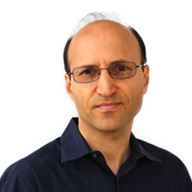
Hamid Jafarkhani
Samueli School of Engineering
University of California, Irvine
Irvine, CA 92697-2625
B.S., Tehran University, Electrical Engineering, 1989
M.S., University of Maryland,College Park, Electrical Engineering, 1994
Ph.D., University of Maryland,College Park, Electrical Engineering, 1997
I am interested in communication theory, signal processing, and machine learning with emphases on coding, wireless communications, image processing, and wireless networks.
My recent work in machine learning and artificial intelligence includes the theoretical and practical challenges of designing distributed and quantized learning algorithms, e.g. federated learning algorithms, that do not need to transmit the collected data over networks. In many applications, multiple access nodes collect and/or disseminate local information over a certain geographical area of interest. In such distributed networks, both data and computational power are distributed. The main challenge is to design robust distributed learning algorithms that only need to communicate a limited number of bits with neighboring nodes instead of sharing the entire collected data.
I have been working on the theoretical and practical challenges of designing communication systems and networks that use multiple antennas and/or relays, especially in the presence of interference. There are many challenges in designing space-time coding and beamforming schemes for multiple-input multiple-output (MIMO) systems and designing distributed methods for cooperative communications especially in the presence of interference. One of these challenges is to study the theoretical tradeoffs and limits from an information theory perspective. Another is to design practical coding and beamforming schemes that satisfy those limits using signal-processing methods.
On a related topic, I have been looking at optimizing resources across different layers of a wireless network. This is in particular important for mobile ad-hoc networks and wireless sensor networks where the traditional layer hierarchies may not exist. I am interested in UAV networks, cross-layer adaptation, network connectivity, power-aware wireless network protocols, optimal node deployment especially for heterogeneous sensor networks and IoT, cooperative communications, and interference cancellation especially for networks with multiple-antenna nodes and relays. Recent challenges involve the design of quantized and distributed machine learning algorithms and trajectory optimization for UAVs.
Also, I have been involved in developing data compression algorithms especially for image and video coding. My work in this field includes the transmission of multimedia information over wireless networks and the Internet. A related topic of interest is the image/video quality estimation especially for a heterogeneous network that supports different resolutions and bandwidth. I am interested in developing new coding schemes and network protocols that improve end-to-end recovery and enhance the quality of service.
Multiscale Image Quality Estimator (MIQE) Software is available here
Multiscale Video Quality Estimator (MVQE) Software is available here
In addition, I have worked on segmenting cardiac images, especially MRIs, using traditional image processing algorithms and machine learning methods. This includes the design of deep learning algorithms for automatic segmentation of heart chambers for both cardiac MRIs and Echocardiograms. In addition, we have designed generative adversarial networks (GANs) to generate synthetic cardiac MRIs and improve the performance of the convolutional neural networks (CNNs) by augmenting the training dataset.
Cardiac MRI LV segmentation software is available here
Cardiac MRI RV segmentation software is available here
